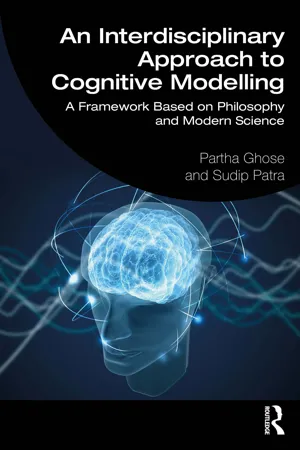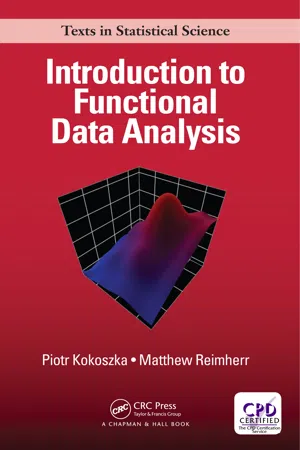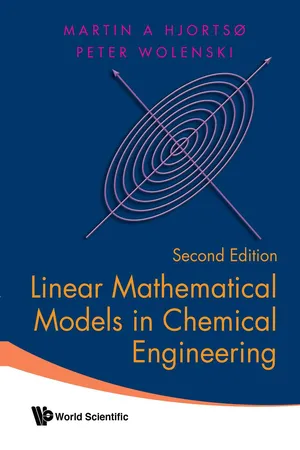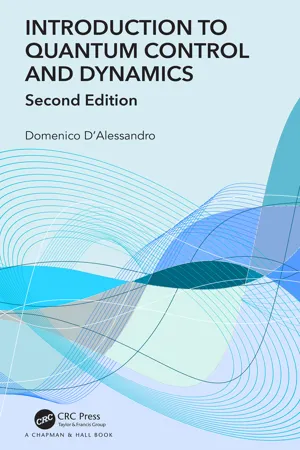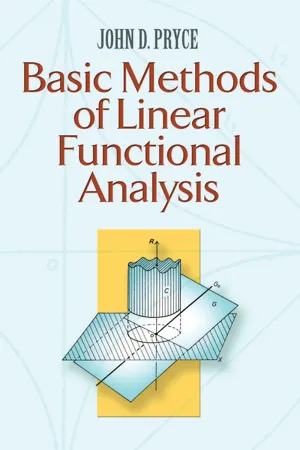Physics
Hilbert Space
Hilbert space is a mathematical concept used in quantum mechanics to describe the state of a quantum system. It is a complex vector space equipped with an inner product that allows for the representation of quantum states and operators. In physics, Hilbert space provides a framework for understanding the behavior and properties of quantum systems.
Written by Perlego with AI-assistance
Related key terms
Related key terms
1 of 4
Related key terms
1 of 3
6 Key excerpts on "Hilbert Space"
- eBook - ePub
An Interdisciplinary Approach to Cognitive Modelling
A Framework Based on Philosophy and Modern Science
- Partha Ghose, Sudip Patra(Authors)
- 2023(Publication Date)
- Routledge(Publisher)
A Hilbert Space is simply a linear vector space H, much like a real linear vector space ℝ n, but complex and spanned by a complete set of orthogonal basis vectors | ψ ⟩ i (i = 1, 2,..., n) and ⟨ ψ | j and on which an inner product and norm are defined. Thus, any ket vector | ψ ⟩ and bra vector ⟨ ϕ | can be written. as | ψ 〉 = ∑ i = 1 n c i | ψ i 〉, (8) 〈 ϕ | = ∑ j = 1 n c j * 〈 ϕ j | (9) with 〈 ϕ | ψ 〉 = ∑ i, j n c j * c i 〈 ϕ j | ψ i 〉, (10) 〈 ψ | ψ 〉 = ∑ i = 1 n | c i | 2 | | ψ i | |[-. -=PLGO-SEPARATOR=--]2. (11) 4.2.2 Entanglement Let us now consider Maxwell’s electrodynamics, the basis of classical optics. The electric and magnetic fields (E → (x, t), B → (x, t)) (x standing for x →) satisfy the wave equations ∇ 2 − 1 c 2 ∂ 2 ∂ t 2 E → (x, t) = 0, (12) ∇ 2 − 1 c 2 ∂ 2 ∂ t 2 B → (x, t) = 0. (13) Now, consider monochromatic stationary state. solutions E → (x, t) = E → (x) exp (− i ω t) with angular frequency ω and the time dependence entirely in the exponential. Stationary waves have the property E → *. E → is time-independent. It’s easy to verify that E → (x) satisfies the Helmholtz equation ∇ 2 − k 2 E → (x) = 0, k = ω c (14) Now, it is well known that a freely propagating electromagnetic wave is transverse, which means the electric and magnetic vectors lie in a plane orthogonal to the direction of propagation. Furthermore, the electric and magnetic vectors are themselves orthogonal: E →. B → = 0. Let the direction of wave propagation be z. Then, the electric and magnetic vectors lie in the (x, y) plane. Consider further the paraxial approximation which is a small-angle approximation used in Gaussian optics in which the divergence of the beam is small, i.e., the angle of divergence θ with the beam axis is such that sin θ ≈ θ, tan θ ≈ θ, cos θ ≈ 1. Laser beams satisfy these conditions because they are very slightly diverging - eBook - ePub
- Piotr Kokoszka, Matthew Reimherr(Authors)
- 2017(Publication Date)
- Chapman and Hall/CRC(Publisher)
There are dozens of other textbooks on Hilbert Spaces; the monographs of Hsing and Eubank (2015) is an exposition taylored specifically to the needs of researchers working in the field of FDA. 10.1 Hilbert Space A vector space is defined over a field of scalars. In this book, the scalars are either the real or the complex numbers. A vector space is a set V whose elements are called vectors, and in which two operations are defined: addition and scalar multiplication. The following are the axioms of a vector space. AXIOM 10.1.1 To every pair of vectors x and y, there corresponds a vector x + y, and x + y = y + x, x + (y + z) = (x + y) + z The space V contains a unique vector 0 such that x + 0 = x for every x ∈ V. For each x ∈ V, there is a unique vector - x such that x + ( - x) = 0. Axiom 10.1.2 To every pair (a, x), where a is a scalar and x is a vector, there corresponds a. vector ax, and l x = x, a (b x) = (a b) x a (x + y) = a x + a y, (a + b) x = a x + b x. All the usual intuitive properties follow from these axioms. For example, if 0 is the scalar zero, then 0 x = 0. A set V 1 ⊂ V is called a linear subspace, or sometimes a vector subspace of V if it is a vector space with respect to the operations defined on V. Clearly, V 1 ⊂ V is a subspace if and only if for any scalars a, b and x, y ∈ V 1, ax + by ∊ V 1. We say that a set of vectors e 1,…., e d of V are linearly independent if a 1 e 1 + a 2 e 2 + … + a d e d = 0 ⇒ a 1 = ⋯ = a d = 0. Furthermore, if every element of V can be expressed as a linear combination of e 1,…, e d, then we call that set of vectors a basis. of V and say that V has dimension d. In the following, we drop the bold face to denote vectors, as it will readily follow from the context which objects are vectors and which are scalars. We will reserve the bold face for finite dimensional vectors (and matrices), as is usual in statistics. This book is primarily concerned with infinite dimensional vector spaces, i.e - Martin A Hjortsø, Peter Wolenski(Authors)
- 2018(Publication Date)
- WSPC(Publisher)
Hilbert Space. We first loosely describe some of the issues and problems that complicate the study of infinite dimensional spaces, and then introduce normed spaces. The concept of a Hilbert Space is a type of normed space that is suitable for many applications, mainly because it admits easy-to-use bases. A particularly important example of a Hilbert Space involves Fourier series, which is discussed in some detail.9.1Infinite dimensional vector spaces
The property required for a vector space to be infinite dimensional was specified in Chapter 5 , and recall this means that there are arbitrarily large sets of linearly independent vectors. For example, any collection of polynomials whose elements have different degree is an independent set, and so it follows that any vector space that contains all polynomials is infinite dimensional.Another collection of independent functions defined on [−1, 1] are the sine functions {sin(nπx)}n=1,∞. To see these as independent, suppose there are scalars C1 ,…,Ckso thatWe will show that all the CThe integrals are evaluated asns must be zero, and therefore the functions are independent. We multiply both sides of Eq. (9.1) by sin(mπx), where m is a positive integer such that m ≤ k, and integrate the resulting equation from x = −1 to x = 1 to getleaving only a single term Cmin the sum. Consequently, Cmmust be 0.We have seen in finite dimensions the usefulness of finding a good basis for a vector space. Any basis gives a unique way to represent the elements of the space as a linear combination. If one is restricted to using only the algebraic property of finite sums in infinite dimensional vector spaces, it generally precludes the use of the most natural bases in function spaces. The idea is to introduce additional structure that defines a notion of convergence so that infinite sums can be defined.First, recall from elementary calculus how the convergence of a series of numbers was defined. If αn∈ F , then the series αnconverges to S provided the partial sums SN= satisfy SN→ S as N → ∞. The same definition can be extended to vector spaces provided that (1) the vector space has a structure that defines the meaning of convergence, and (2) the limiting object will always remain in the space. The structure required for (1) is called a norm, and is introduced in Section 9.1.2 . The property (2) depends on the norm, and if it holds, then the space has the desirable property of being complete- eBook - ePub
- Domenico D'Alessandro(Author)
- 2021(Publication Date)
- Chapman and Hall/CRC(Publisher)
For this reason, it is often more appropriate to speak about rays or directions in the Hilbert Space H as representing the state of a quantum system. In choosing a representative among the vectors proportional to | ψ 〉, one often picks a vector with unit norm. Therefore, it is often assumed that the vector representing the state of the system has norm equal to one, i.e., for every | ψ 〉, 〈 ψ | ψ 〉 = | | | ψ 〉 | | 2 = 1. Physical states can be viewed as points on a complex sphere with radius one in a Hilbert Space, with points differing by a phase factor treated as the same state. 1.1.1.4 Dimension of a quantum system In modeling a quantum system with an appropriate Hilbert Space one chooses a set of states that 1) have a definite physical meaning, e.g., each state corresponds to a given energy or each state corresponds to a given position, etc. and 2) form an orthonormal basis of the Hilbert Space which means that conditions (1.3) and (1.4) are verified. Conditions (1.3) and (1.4) are written for a countable set but they generalize for an uncountable set. In particular, in the latter case, the sum is replaced by an integral (cf. 1.1.2.4). According to the meaning of this preferred basis, we say that we work in a given representation. For example, if the chosen vectors represent states with given values of the energy, we say that we work in the energy representation. The dimension refers to the cardinality of the preferred set of states. It could be finite, countably infinite or noncountably infinite. In the energy representation, the dimension is called the number of levels (of energy). This terminology is justified by the measurement postulate which will be discussed in section 1.2, in that, the preferred states correspond to eigenvectors of linear operators on the Hilbert Space. The simplest, but very important, example of a quantum system is a two-dimensional (or two-level) system which has a pair of distinguished orthonormal states, say | 0 〉 and | 1 〉 - eBook - ePub
- Hailong Li, Fuhuo Li;Nianliang Wang;Shigeru Kanemitsu(Authors)
- 2017(Publication Date)
- WSPC(Publisher)
There is an enormous amount of excellent books on the theory of Hilbert Spaces and the interested reader can consult them. What is given in this section is a very brief summary of the theory which is meant to give a feeling to beginners so as to go on reading topics using the theory. For an excellent exposition of the theory of Hilbert Spaces, cf. e.g. [Yoshida (1967)] and [Halmos (1950)]. Our exposition follows closely the former book with slight deviations and modifications.A (complex) pre-Hilbert Space is a vector space over the complex numbers with inner product defined below.A (complex) Hilbert Space H is a pre-Hilbert Space such that it is complete, i.e. every Cauchy sequence in H ((5.9) below) is convergent with respect to the distance arising from the inner product.The inner product of a, b ∈ H is denoted (a, b) and it satisfies for a, b, c ∈ H and λ ∈ the following(i) (a, a) ≥ 0 and (a, a) = 0 a = 0.(ii) the bar meaning the complex conjugate.(iii) (linearity in the first factor) (a + b, c) = (a, b) + (a, c), (λa, b) = λ(a, b).It follows that (a, b + c) = (a, b) + (a, c) andExercise 25. LetThen prove that this satisfies the properties of norm:(i) ||a|| ≥ 0 and ||a|| = 0 ⇔ a = 0.(ii) ||λa|| = |λ|||a||.(iii) (triangular inequality) ||a + b|| ≤ ||a|| + ||b||.Solution. To prove (iii) we first need to prove the Cauchy-Schwarz inequalityIf either of a or b is 0, (5.2) is clear. Supposing a ≠ 0 we consider the quadratic expression in t:Since this is non-negative, its discriminant is non-negative, implying (5.2). Equality holds when a + tb = 0, i.e. when a and b are parallel.Now (5.3) with t = 1 readswhence (iii). Exercise 26. LetThen prove that d satisfies the axioms of distance(i) d(a, b) ≥ 0 and d(a, b) = 0 a = b.(ii) d(b, a) = d(a, b).(iii) (triangular inequality) d(a, b) ≤ d(a, c) + d(c, b).Definition 5.1. We may speak of topological properties of a Hilbert Space as a metric space with metric d.If the sequence {an } ⊂ H satisfieswe write limn→∞an = a (strong) or an → a (strong) and say that {an } converges (or is convergent) strongly to a or simply converges when it is clear that convergence is with respect to norm. On the other hand, a sequence {yn } is said to be weakly - eBook - ePub
- John D. Pryce(Author)
- 2014(Publication Date)
- Dover Publications(Publisher)
a. c. Hilbert Spaces have a structure which copies the algebraic properties of the dot product, and this gives them a rich geometric structure which is essentially Euclidean. They are ideally suited to certain problems of analysis, and even today it is possible to spend all one’s mathematical life investigating the properties of operators on Hilbert Spaces. This section treats the basic properties of the space itself, and we take up the rather distinct topic of operators in §18.Diagram 15.12.1 A real inner-product space is a real linear space X on which is defined a function ϕ: X × X → R, the inner product, whose value ϕ (x, y) is written as x, y (orx.y, especially in applied mathematics), obeying the rulesWe always assume that an inner-produce space carries the norm defined byThat it is really a norm is proved in Corollary 12.8 .From P1 and P2 we see that ϕ also satisfiesThus ϕ is linear in each argument separately and is called a bilinear functional (or bilinear form).12.2 Example 1 The set of all vectors in ordinary space, with the dot product, is a 3-dimensional real inner-product space, the norm coinciding with the usual idea of length. (In fact all of Euclidean geometry can be derived from the preceding sentence.)Example 2 Rn is a real inner-product space X with the inner productThis gives , so that as a normed space X is identical with .Example 3 Let A be an n × n real matrix. Then Rn becomes a real inner product space underif, and only if, A is symmetric and positive definite. Example 2 is the case A = I. (Here y denotes y regarded as a column matrix, xT denotes x regarded as a row matrix; if the reader doesn’t know what a symmetric positive definite matrix is it doesn’t matter.)The deeper applications of inner-product spaces are mostly to two (related) areas: Fourier series and the spectral analysis of linear operators. In order to get a satisfactory theory it is desirable in the first and essential in the second that the scalars be complex: this turns out to be closely connected with the fact that every nonconstant polynomial with complex coefficients has a complex zero, whereas there exist polynomials with real coefficients and no real zeros.
Index pages curate the most relevant extracts from our library of academic textbooks. They’ve been created using an in-house natural language model (NLM), each adding context and meaning to key research topics.
Explore more topic indexes
Explore more topic indexes
1 of 6
Explore more topic indexes
1 of 4
